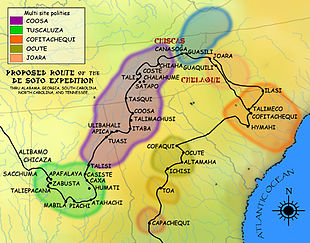| Battle of Mávilla | |||||
|---|---|---|---|---|---|
| Part of Spanish colonization of the Americas | |||||
| |||||
| Belligerents | |||||
| Habsburg Spain | Chiefdom of Tuskalusa | ||||
| Commanders and leaders | |||||
| Hernando de Soto | Tuskaloosa | ||||
| Strength | |||||
| around 600 Spaniards | over 3,000 | ||||
| Casualties and losses | |||||
| 200 | 2,500-3,000? | ||||
Mabila[1] (also spelled Mavila, Mavilla, Maubila, or Mauvilla, as influenced by Spanish or French transliterations)[2] was a small fortress town known to the paramount chief Tuskaloosa in 1540, in a region of present-day central Alabama.[1] The exact location has been debated for centuries, but southwest of present-day Selma, Alabama, is one possibility. In late 2021, archaeologists announced the excavation of Spanish artifacts at several Native American settlement sites in Marengo County that indicate that they have found the historical province of Mabila, although not the town itself. They theorize that the town site is within a few miles of their excavations.[3]
In 1540 Chief Tuskaloosa arranged for more than 2,500 native warriors to be concealed at Mabila, prepared to attack a large party of foreign invaders in the Mississippian culture territory: Spanish explorer Hernando de Soto and his expedition.[1]

When Hernando de Soto first met Tuskaloosa at his home village and asked him for supplies, Tuskaloosa advised them to travel to another of his towns, known as Mabila, where supplies would be waiting. A native messenger was sent ahead to Mabila. When Tuskaloosa arrived with the first group of Spaniards, he asked the Spanish people to leave the settlement and territory. A fight broke out between a soldier and a native, and many warriors emerged from hiding in houses and began shooting arrows at the Spaniards.[1] The Spaniards fled, leaving their possessions inside the fortress. The conflict that resulted is called the Battle of Mabila. Armed with guns, the Spaniards eventually burned down the village and killed most of the warriors.[1][4]
- ^ a b c d e Sylvia Flowers, "DeSoto's Expedition", U.S. National Park Service, 2007, webpage: NPS-DeSoto.
- ^ Cite error: The named reference
MMwas invoked but never defined (see the help page). - ^ "Mystery solved? Alabama researchers close in on pivotal battle site". 14 November 2021.
- ^ The single primary source about DeSoto's expedition was written by Hernández de Biedma. Another account, usually described as that of DeSoto's aide Rodrigo Ranjel, survives only partially in a summary history written by Gonzalo Fernández de Oviedo y Valdés. That secondary source had a strong influence on the formation of the text generally known as the Relaçam of the "Gentleman of Elvas" and, in turn, on the writing of Garcilaso de la Vega's Florida del Inca. (see review of The Hernando de Soto Expedition: History, Historiography, and Discovery in the Southeast in Journal of Interdisciplinary History 30.3, Winter 1999, webpage: SIU-G Archived 2009-03-17 at the Wayback Machine).
